This unique and fun birding and wildlife challenge provides the opportunity to explore the world-famous Kruger National Park in north-eastern South Africa, from its remote north to its vast south. Not only will you get to experience amazing birding and wildlife viewing but you will also be assisting in saving a special bird from imminent extinction. All proceeds raised will go directly to BirdLife South Africa for vital research and conservation work to protect one of Africa’s, and indeed the worlds, most endangered and little-known species – the White-winged Flufftail. Rockjumper Birding Tours has volunteered its resources and expertise to arrange and coordinate this event and will not be benefitting financially.
Kruger National Park is one of Africa’s most famous, oldest, largest and magnificent reserves and will play host to this birding and wildlife challenge during February 2023. In total, a maximum of 19 teams will take part in what will be a light-hearted, exciting competition where teams explore Kruger National Park from top to bottom recording all the species of birds and mammals they encounter over a 7-day period. Each team of up to 9 participants will have its own open safari vehicle, professional safari driver-guide, and experienced volunteer birding leader. Each species of bird and mammal has been allocated points based on the difficulty of locating the species, and the team with the highest score at the end of the 7 days will be crowned the Birding & Wildlife Champions of Kruger. During the challenge, most teams will be exploring the entire length of Kruger – from Berg-en-dal Camp in the south to Punda Maria in the north. There are however a few alternative routes to choose from that are less intense and focus on specific sectors of Kruger (either the south or north). We also have a few exclusive routes that spend time in some of the bush camps, routes that are more centered around photography, and others that take in some of the private concessions in the far north of Kruger, around the Pafuri region. All teams will start in Skukuza with a welcome dinner and end in Mopani for an epic final night of festivities and prize-giving.
The Kruger list stands at over 500 species of birds, and the park is also renowned for its big game and other mammalian fauna (over 150 species recorded to date). This is one of the few places on the planet where iconic African mammals such as Lion, Leopard, Cheetah, African Wild Dog, African Elephant, African Buffalo and White Rhinoceros can still be found in healthy numbers. There is also a huge variety of other mammals including Roan Antelope, Hippopotamus, Black Rhinoceros, African Civet, Honey Badger, Serval and Cape Porcupine.
Bigger than several European countries and US States this vast, pristine park, declared in 1898 by President Kruger of the Transvaal Republic, is home to a variety of different habitat types. These range from acacia-dominated bushveld to gallery forest along the rivers and mopane woodland in the north. Associated with these habitats is an extraordinary volume of birds, and our time in the park is likely to produce a huge variety that could include Arnott’s Chat, Brown-necked and Brown-headed Parrots, Dickinson’s Kestrel, Green-capped Eremomela, Thick-billed Cuckoo, Mosque Swallow, White-breasted Cuckooshrike, Racket-tailed Roller, Bronze-winged Courser, Stierling’s Wren-Warbler, Olive-tree, Icterine and River Warblers, Thrush Nightingale, Retz’s Helmetshrike, African Barred Owlet, Narina Trogon, Black-throated Wattle-eye, Lemon-breasted Canary, Mottled and Bohm’s Spinetails, Senegal and White-crowned Lapwings, Monotonous and Dusky Larks, Bearded Scrub Robin, African Finfoot, Meves’s Starling, Pallid and Montagu’s Harriers, Steppe and Lesser Spotted Eagles, Amur Falcon, Eurasian Hobby, Bushveld Pipit, Coqui Francolin, Harlequin Quail, Corn Crake, Gorgeous Bushshrike, Eastern Nicator, Eurasian Golden Oriole, Yellow-billed Oxpecker and Tropical Boubou. Kruger is also famous for producing national and regional rarities, with species such as Egyptian Vulture, African Skimmer, Orange-winged Pytilia, Northern Wheatear, Southern Hyliota, Broad-tailed Paradise Whydah, Miombo Blue-eared Starling, Madagascan Cuckoo, Basra Reed Warbler, Sooty Falcon and Collared Palm Thrush all being recorded in the past.
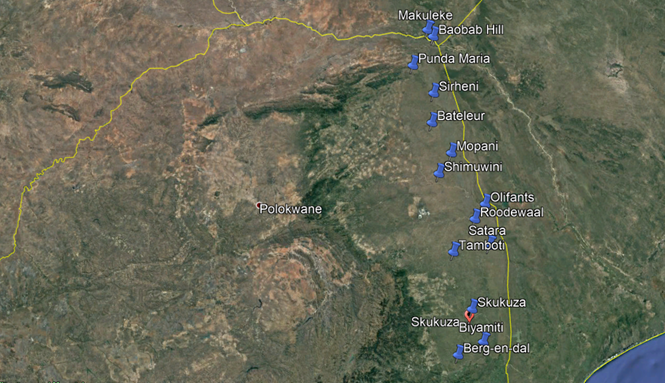
THE CHALLENGE ROUTE AT A GLANCE
Below is a selection of the different routes that can be chosen. All teams begin in Skukuza and on the final night, all teams will be based at Mopani for a final night of festivities and prize-giving.
Participants will either meet in Johannesburg at 8am on February 12th or at Skukuza Camp if you prefer. The challenge count will officially kick-off at 3pm on February 12th and will end at 5pm on February 19th. Each team can tally species recorded from the time the camps officially open until they close (sunrise to sunset) and 2 night drives will also be allowed per team (cost included in the challenge fee).
COMPETITIVE
| 1 Night | Skukuza |
| 1 Night | Satara |
| 2 Nights | Olifants |
| 2 Nights | Punda Maria |
| 1 Night | Mopani |
NON-COMPETITIVE – SOUTHERN & PHOTO
| 1 Night | Skukuza |
| 3 Nights | Berg-en-dal |
| 2 Nights | Olifants |
| 1 Night | Mopani |
NON-COMPETITIVE – NORTHERN
| 1 Night | Skukuza |
| 1 Night | Olifants |
| 2 Nights | Shingwedzi |
| 2 Nights | Makuluke Concession |
| 1 Night | Mopani |
EXCLUSIVE (ROUTE 1)
| 1 Night | Skukuza |
| 2 Nights | Biyamiti |
| 2 Nights | Tamboti |
| 1 Night | Shimuweni |
| 1 Night | Mopani |
EXCLUSIVE (ROUTE 2)
| 1 Night | Skukuza |
| 2 Nights | Tamboti |
| 1 Night | Shimuweni |
| 2 Nights | Sirheni |
| 1 Night | Mopani |
EXCLUSIVE (ROUTE 3)
| 1 Night | Skukuza |
| 2 Nights | Talamati |
| 1 Night | Shimuweni |
| 2 Nights | Sirheni |
| 1 Night | Mopani |
BERG-EN-DAL & BIYAMITI
These are two of Kruger’s southernmost camps and offer up a good variety of habitat to explore. To the east, the Crocodile River and its associated thickets and riverine vegetation can be easily accessed from Byamiti and Berg-en-dal. Byamiti is set out in amongst riverine vegetation and thickets and offers great woodland birding and is well located for Leopard sightings as well. Berg-en-dal meanwhile is surrounded by numerous rocky outcrops, which in turn host a few unique species that can be tricky to locate elsewhere in the park. Both camps also offer access to the hills around Pretoriuskop – another option for additional species that are unlikely to be seen elsewhere.
Berg-en-dal is a large camp and offers up some excellent general bushveld birding while Byamiti is a smaller exclusive busshveld camp. Both offer typical species for the area such as Magpie Shrike, Orange-breasted Bushshrike, Chinspot Batis, Golden-breasted Bunting, Blue Waxbill, Green-winged Pytilia, Yellow-fronted Canary, Black-crowned Tchagra, Black-backed Puffback, Long-billed Crombec, ubiquitous Rattling Cisticola and Southern Black Tit are common and easy to find.
The diminutive Pearl-spotted Owlet – a diurnal owl with a lovely, characteristic call – is also a regular in this area, and wherever present or calling it never fails to attract the attention of numerous birds. At Berg-en-dal there is a small dam, which occasionally produces some interesting species: even White-backed Night Heron and African Finfoot have been recorded before. The thick woodlands surrounding both camps can be some of the best places in the park to search for the uncommon Stierling’s Wren-Warbler; while raptors are also regularly recorded, with Dark Chanting Goshawk often occurring here at higher density than elsewhere in the park. It is also a very good area for Brown Snake, African Hawk-, Wahlberg’s and Martial Eagles; while Gabar Goshawk and Lizard Buzzard are also frequently seen. The riverine zones and thickets associated with the Crocodile River can often be a good place to try for the uncommon African Barred Owlet; while many other common species including Emerald-spotted Wood Dove, Jacobin, Levaillant’s, Klaas’s and Diederik Cuckoos, Burchell’s Coucal, Little Bee-eater, Brown-hooded and Woodland Kingfishers, Red-breasted Swallow, Willow Warbler, Southern Black, Ashy, Spotted and Pale Flycatchers, Black Cuckooshrike, Red-faced Cisticola, Black-headed Oriole, Black-collared Barbet, Red-faced Mousebird and Green Wood Hoopoe can also be found.
Over towards Pretoriuskop, the woodland and habitat change a little and it is well worth spending some time birding this area if time allows. There are two loops, in particular, that take you very close to some rocky outcrops that are good for finding Mocking Cliff Chat, Striped Pipit, Croaking and Lazy Cisticolas, Red-winged Starling, the near-endemic White-throated Robin-Chat, Cinnamon-breasted Bunting and even Gorgeous Bushshrike in the dense thickets that are associated with the outcrops. Pretoriuskop camp is situated in a zone of broad-leaved woodland, which can produce some interesting species such as Green-capped and Yellow-bellied Eremomelas, the tiny Grey Penduline Tit, Bushveld Pipit, Flappet Lark, Groundscraper Thrush, Yellow-throated Petronia, Striped Kingfisher and Yellow-fronted Tinkerbird. The area is also very good for a variety of sunbirds, and common species include White-bellied, Marico and Scarlet-chested; while this is one of the few areas of the park where Amethyst Sunbird can also sometimes be found.
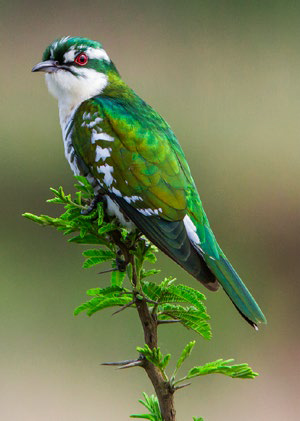
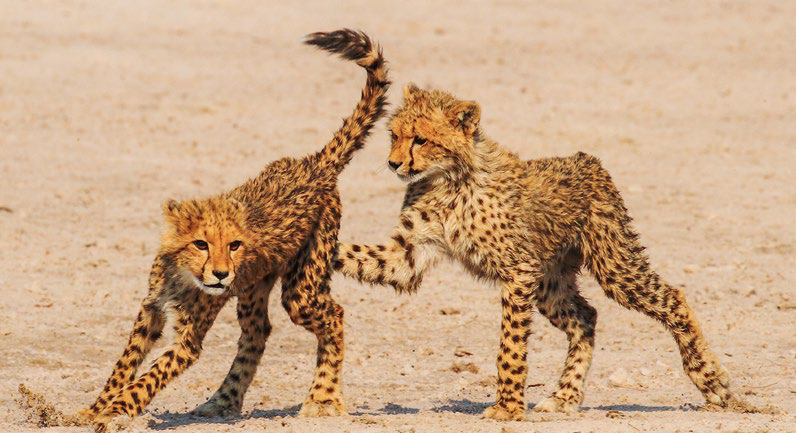
SKUKUZA
This camp is one of the most popular in all of Kruger, and is also the largest. The vast camp grounds themselves provide great birding and easy access to excellent riverine thicket and woodland dominated by large Sycamore Figs and Sausage Trees, which is often a magnet for birds. Skukuza is situated on the Sabi River, and there is an excellent network of roads that allow for plenty of quality access to the river and its associated woodland, both east and west of the camp. Much of the surrounding woodland is fairly dense in nature, even away from the river itself.
Skukuza offers excellent chances at finding the majestic Southern Ground Hornbill, which is often seen striding around in small groups, and we will certainly be treated to many encounters with the gaudy Lilac-breasted Roller. Raptors are also numerous in this area, and we will no doubt enjoy sightings of the striking Bateleur, as well as Tawny and Wahlberg’s Eagles, Hooded, White-headed, White-backed and huge Lappet-faced Vultures, and the handsome African Fish Eagle; while other possibilities include Shikra, Lizard Buzzard, Gabar and Dark Chanting Goshawks, the scarce but extremely attractive African Cuckoo-Hawk, Black-chested and Brown Snake Eagles, Lesser Spotted, Steppe, African Crowned and Booted Eagles, African Hawk-Eagle and African Harrier-Hawk.
This area is also famous for regular sightings of the elusive African Wild Dog; while we also stand an excellent chance of finding the endangered White Rhinoceros and, with exceptional luck, its rarer cousin, the Black Rhinoceros. It is also one of the best areas in the park to see the crepuscular Leopard – certainly one of the world’s best-looking cats! In addition, we should encounter Lion, Spotted Hyena, Black-backed Jackal, large herds of African Elephant lounging in the Sabi River, herds of African Buffalo, Waterbuck, the beautiful Bushbuck and pods of Hippopotamus. The persistent troops of playful Chacma Baboons and Vervets will keep us entertained during the heat of the day. The nocturnal Greater Galago is common in the fig trees inside the camp itself.
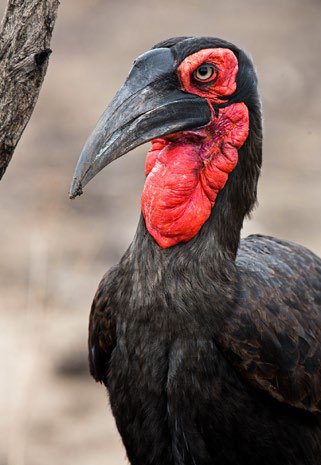
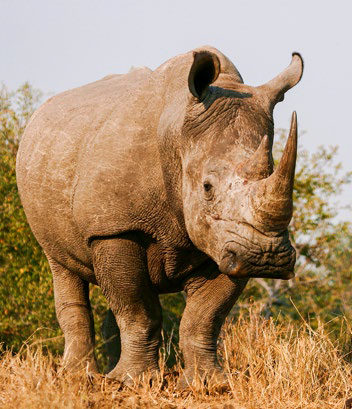
Scouring the riverine woodland and thickets along the Sabi River, we hope to encounter White-fronted Bee-eater, Crowned Hornbill, Golden-tailed, Bearded and Cardinal Woodpeckers, Ashy Flycatcher, Grey Tit-Flycatcher, gorgeous White-browed and Red-capped Robin-Chats, Terrestrial Brownbul, Yellow-bellied and Sombre Greenbuls, African, Jameson’s and Red-billed Firefinches, superb Green-winged Pytilia, Bronze Mannikin, Common Waxbill, Pin-tailed Whydah, Red-faced Cisticola and Southern Boubou. The large riparian trees lining the rivers provide perfect nesting sites for weavers, which are extremely well represented in the park and include Southern and Lesser Masked, Village, Spectacled and Thick-billed. Furthermore, we will endeavour to see various species of brightly coloured bee-eaters, kingfishers, rollers and hornbills, along with the occasional Pearl-spotted Owlet. The Sabi River and nearby wetlands also harbour a number of exciting water-associated birds, and we will be on the lookout for the massive Goliath Heron, stately and threatened Saddle-billed Stork as well as the more common Woolly-necked and Yellow-billed Storks, African Spoonbill, Striated Heron, the unique and monotypic Hamerkop, African Black Duck, Wire-tailed and Grey-rumped Swallows, African Pied Wagtail, White-crowed Lapwing, Common Greenshank, Wood Sandpiper, Giant, the delightful Malachite and occasionally Half-collared Kingfishers and, if we are lucky, the rare African Finfoot or unpredictable Greater Painted-snipe.
Time spent birding in Skukuza camp will almost certainly produce African Green Pigeon, with its lovely, mournful, liquid call; while the thickets in camp are excellent for Bearded Scrub-Robin and White-browed and Red-capped Robin-Chats. Other species that are regularly seen in or from the camp include the tiny Little Sparrowhawk, African Goshawk, Water Thick-knee, gaudy Purple-crested Turaco, Trumpeter Hornbill, Black-headed Oriole, the showy African Paradise Flycatcher, Arrow-marked Babbler, Yellow-breasted Apalis, Green-backed Camaroptera, iridescent Collared, Marico, White-bellied and Scarlet-chested Sunbirds and the vocal Black-collared and Crested Barbets.
Noisy flocks of White-crested Helmetshrike are regularly encountered, and we will also be on the lookout for the much rarer Retz’s Helmetshrike, along with its seldom-seen host, the rare and much sought-after Thick-billed Cuckoo. In addition, we will keep a lookout for the amazing selection of migrant cuckoos that visit the park in summer, and these include African, Common, Red-chested, Diederik, Klaas’s, Levaillant’s and Jacobin Cuckoos, as well as the scarce Great Spotted Cuckoo.
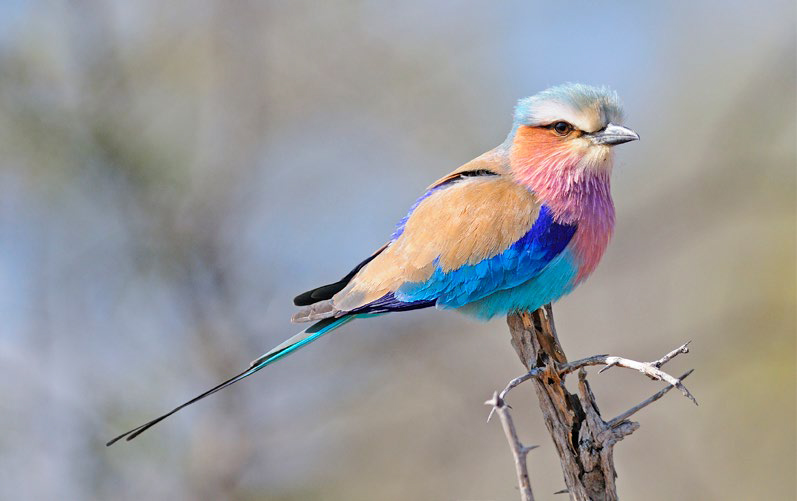
OLIFANTS, TAMBOTI, TALAMATI & SATARA
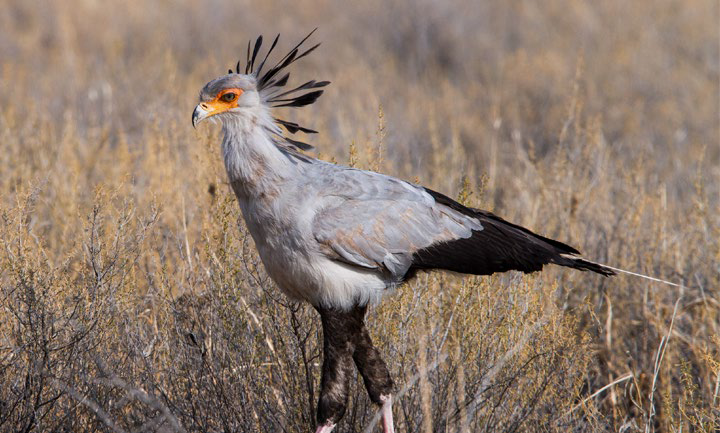
This region is often referred to as central Kruger and offers excellent game viewing and birding opportunities. Olifants is a beautiful camp, set on top of a hill with splendid views of the Olifants River below. Being centrally located has numerous benefits, as a wide variety of habitats can be accessed irrespective of the camp you are staying at. These camps are situated on the southern edge of the widely distributed mopane woodland with Satara and Tamboti the furthest south. While mopane as a vegetation type doesn’t hold a wide variety of species, it does have a few specials. From Olifants, there are excellent opportunities to venture south onto the open grassy plains and sparsely vegetated woodlands in the Satara, Talamati and Tamboti areas; while time can also be spent exploring the denser bush country associated with the Olifants River and the mopane woodlands to the north. Further north of Olifants is the Letaba River, which is another area well worth exploring. Letaba has some lovely thickets and tall riverine habitat, including Letaba Camp, which can be especially productive.
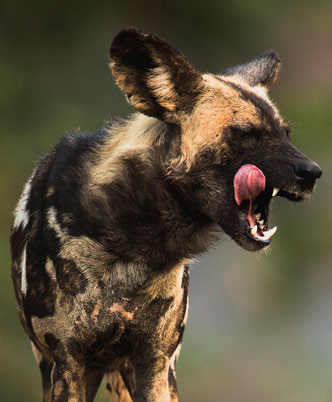
Olifants camp is an excellent place to see Southern Yellow-billed and Southern Red-billed Hornbills, Bennett’s Woodpecker, African Hoopoe, Grey-headed and Orange-breasted Bushshrikes, Red-headed Weaver, Red-billed Buffalo Weaver, Burchell’s Starling, Mourning Collared Dove and Brown-headed Parrot, amongst many others.
To the south of Olifants, the rich bushveld and grasslands are particularly productive for several special species. These include Kori Bustard – the world’s heaviest flying bird, the magnificent Martial Eagle, Bateleur, Common Ostrich, Marabou Stork and the impressive Secretarybird – a monotypic family and one of the world’s great avian gems. Further specialities that we will search for in the woodland areas include the lovely Orange-breasted and Grey-headed Bushshrikes, African Grey Hornbill, Lesser Grey, Red-backed, Southern White-crowned and Magpie Shrikes, Red-billed Oxpecker riding on the backs of big game, Red-crested Korhaan, Southern Black Tit, noisy Green Wood Hoopoe, Common Scimitarbill, Greater and Lesser Honeyguides, Acacia Pied Barbet, Yellow-fronted Tinkerbird, Sabota Lark, Mosque Swallow, Black Cuckooshrike, Kurrichane and Groundscraper Thrushes, eye-catching White-throated Robin-Chat, melodic White-browed Scrub Robin, Burnt-necked and Yellow-bellied Eremomelas, Black-crowned and Brown-crowned Tchagras, Brubru, dazzling Violet-backed Starling, White-winged Widowbird and Golden-breasted Bunting.
In the expansive grasslands, we will seek out the bold Black-bellied Bustard, Crested and the rare Shelley’s and Coqui Francolins, Swainson’s and Natal Spurfowls, Rufous-naped Lark, Chestnut-backed Sparrow-Lark, European and Purple Rollers, Yellow-throated Longclaw and, with luck, the erratic and nomadic Temminck’s Courser and Crowned and the scarce Senegal Lapwings. This time of the year can also be good for Harlequin Quail and Kurrichane (Small) Buttonquail; while, sometimes, species such as African and Corn Crakes can also be found in the moist grasslands. It is also during mid to late summer when huge flocks of Red-billed Quelea breed in this area. Seeing flocks of these avian locusts filling the sky or descending on a waterhole is an incredible sight, and their eruptions usually also bring about additional interest in the form of Steppe and Lesser Spotted Eagles. It is also during this time of the year when termite alate eruptions take place, sparking the interest of the afore-mentioned raptors, as well as Amur and occasionally Red-footed Falcons, Lesser Kestrel and Eurasian Hobby. Additional summer visitors to these grasslands also include the scarce Pallid and Montagu’s Harriers. In the late afternoon, pairs of boldly-patterned and crepuscular Double-banded Sandgrouse come to the edges of the road to feed, before making their way down to watering holes at dusk to drink.
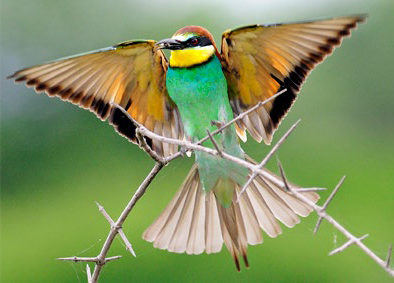
The sweet grasses in the Satara area are, of course, also excellent for large herds of grazing mammals, such as Common Wildebeest, Plains Zebra and Impala. These huge herds, in turn, support a healthy population of predators, and Satara is particularly well-known for this. In fact, we have an excellent chance of finding Lion, Leopard, Cheetah, Spotted Hyena and the very scarce and highly threatened African Wild Dog in this area. High densities of other game include Southern Giraffe, Greater Kudu, Klipspringer, Bushbuck, Warthog, Chacma Baboon, Vervet and Dwarf and Banded Mongooses, to name just a few.
To the north of Olifants camp are the Letaba River and its associated camp (Letaba), which also offers some excellent birding opportunities. Like many other Kruger camps, it is also situated right on the river, which ensures fabulous access to quality habitat. Letaba camp can be a good place to look for African Barred Owlet, African Scops Owl and Pearl-spotted Owlet; while the river itself is one of the best locations in the park for Grey-rumped Swallow. Other good species include White-crowned Lapwing, Red-capped Robin-Chat and Green-capped Eremomela.
SHINGWEDZI, BATELEUR & SIRHENI
All three camps are in the northern region of Kruger which is justly famous for birding. Shingwedzi camp is fairly large while both Bateleur and Sirheni are smaller bushveld camps that have been included on the exclusive routes. Like many of the camps we stay at during the challenge, Shingwedzi is also situated on a river – the beautiful Shingwedzi, which is often one of the first rivers in the park to stop flowing during drought years. During wet seasons, however, the river can flow strongly and can be quite a site. It also offers good access to excellent riverine woodland and thickets with an extensive road network comprising many loops and a hide (blind) with wonderful views over the river. Mopane dominates the drier areas away from the river to the north and south. North of Shingwedzi towards Sirheni is a river road that follows the Mphongolo River and can offer some good birding opportunities. Further north, towards Babalala, the woodlands give way to more open habitat, with dotted low bushes and grassland, and this area can be extremely productive as well, particularly during the mid to late summer months.
Given time in the area Shingwedzi camp itself is certainly worth exploring, especially during the summer months when migrant warblers are often about, as this is often a good place to look for Thrush Nightingale. The camp has also famously produced Collared Palm Thrush in the past – a mega record for the park and South Africa. Other regular species include Red-headed Weaver, Bennett’s Woodpecker and Mourning Collared Dove.
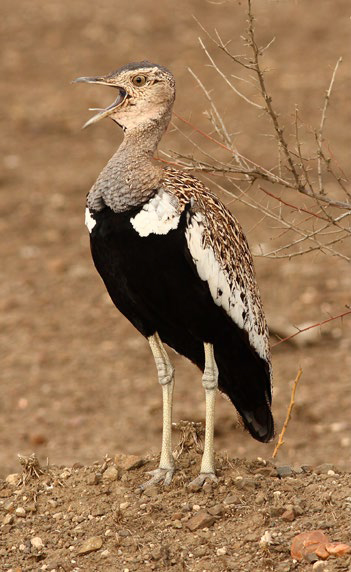
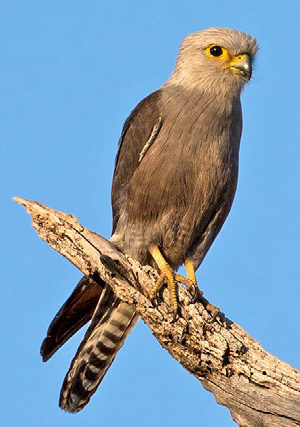
Near to Shingwedzi is the Kanniedood Dam, which provides further opportunities to boost the waterbird list. As with most Kruger dams, the volume of species is water level dependent; however, Kanniedood can often hold a fair variety of waders, including Marsh Sandpiper and occasionally even White-fronted Plover. To the south of Shingwedzi is some excellent grassland and scattered bush habitat, which is generally very good for species such as Red-crested Korhaan, Black-bellied Bustard, Southern Carmine and European Bee-eaters, Chestnut-backed Sparrow-Lark, Zitting and Desert Cisticolas and even species such as Dusky and Monotonous Larks, when conditions are right.
The area around Sirheni and further north is another fabulous area of open grassland and scattered bush, which again can produce a variety of excellent species. During the summer months, species such as European Roller and Red-backed Shrike are commonly found; while during times of good rainfall, birds that pull in include Harlequin Quail and African and Corn Crakes. Pallid and Montagu’s Harriers, Monotonous and Dusky Larks, Amur and Red-footed Falcons and Lesser Kestrel should all be looked for carefully. Further north towards the junction of the H1-8 and the H13-1, there have even been records of Black Coucal and Rufous-winged Cisticola – both rare birds in Kruger.
PUNDA MARIA & PAFURI AREA (MAKULEKE CONCESSION)
The far northern Punda Maria and Pafuri areas, bordering Zimbabwe and Mozambique, offer up the best birding in all of Kruger, and many species that are typically only found further north are recorded from this section of the park. Punda is situated around a small hill/kopje and even the camp offers up some fabulous birding. The surrounding woodland, which includes the Mahonie Loop, offers up wonderful mixed woodland; while some excellent tall mopane, that holds a variety of specials, can be found between Punda Maria and Klopperfontein and also on the main tar road that leads east along the H13-1 to the junction of the main north-south route from Pafuri to Shingwedzi. The area around Klopperfontein can be extremely productive, as the taller woodlands give way to more open country, with several small wetlands that usually fill up during the rains. One of the major target zones will also be the stunning riverine woodland that flanks the Luvhuvhu River. There is a superb road network in this area, which allows for extensive exploration of this incredible habitat that teams with birds.
The area around the Mahonie Loop and Punda Maria camp offer up a feast of specials in addition to many of Kruger’s more widespread species, and good birds to keep a watch out for include Brown-necked (Grey-headed) Parrot, Eastern Nicator, Narina Trogon, Yellow-bellied Greenbul, Mosque Swallow, Common House Martin, White-breasted Cuckooshrike, Stierling’s Wren-Warbler, Broad-billed Roller, Eurasian Golden Oriole, River Warbler, White Stork, Steppe and Lesser Spotted Eagles, Eurasian Hobby, African Barred Owlet, Yellow-billed Oxpecker, Red-collared Widowbird, Long-tailed Paradise Whydah, Bronze-winged Courser, Double-banded Sandgrouse and Kurrichane (Small) Buttonquail; while numerous rarities have been reported from this loop before, such as Southern Hyliota, African Golden Oriole, Orange-winged Pytilia and Broad-tailed Paradise Whydah. The area also hosts an incredible variety of cuckoos; however, these do become more difficult to find post-breeding once they have stopped calling. Species to look out for include African, Common, Red-chested, Black, Levaillant’s, Jacobin, Great Spotted, Diederik, Klaas’s and Thick-billed.
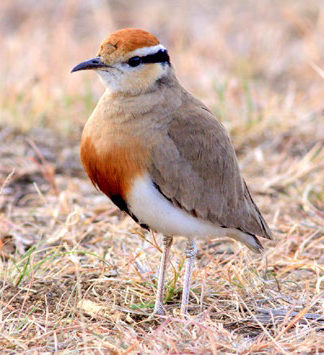
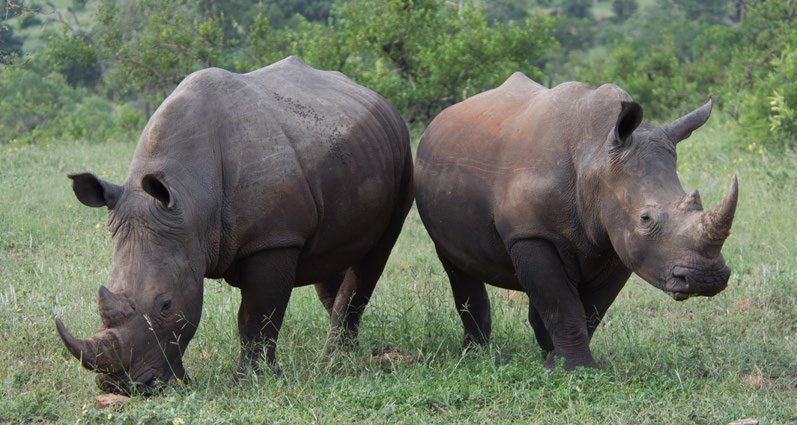
To the east of Punda Maria and north towards Klopperfontein is some of the park’s finest mopane woodlands, and it is here where one stands the best chance of finding specials such as Arnott’s Chat and White-breasted Cuckooshrike. Racket-tailed Roller has also been seen here but is rare and seldom-recorded. The area around Klopperfonetin always seems to produce something good, and this is also the best area of the park to look out for Dickinson’s Kestrel; while Senegal Coucal has also been found here recently. The small wetlands occasionally hold Greater Painted-snipe, Lesser Moorhen and Intermediate Egret when conditions are favourable; while Three-banded Plover, Little Grebe, White-faced Whistling and Knob-billed Ducks, Black Crake and African Jacana are usually around.
Further north, the area around Pafuri holds arguably the most exciting birding in all of Kruger. The area can either be visited during a day trip from Punda Maria or else explored extensively while based in the Makuleke Concession or at Baobab Hill. The beautiful Luvhuvhu River holds an exceptional density of birds, and we will be on the lookout for an incredible variety of common and special species. The main bridge crossing over the river is a good place to scan for African Finfoot, which can occasionally be seen here; while Tropical Boubou and Eastern Nicator are regularly seen in the undergrowth. Overhead, there are often swifts and swallows about; and whilst Little Swift is commonly seen, the two special spinetails – Bohm’s and Mottled – the latter is now rather rare these days, should be watched for carefully in this area. Horus Swift is another good bird to keep an eye open for. To the north of the river crossing are some large acacias that often hold Olivetree and Icterine Warblers during the mid to late summer months; while the rare and often overlooked River Warbler has also been seen here. Common Whitethroat and Garden Warbler are two other migratory warblers that are regularly found in the Pafuri area. There have also been records of Basra Reed Warbler from the Luvhuvhu; however, this is a rare vagrant. To the south of the bridge, one gets to an area of palm-dominated savanna, where careful looking and patience could be rewarded with a sighting of the scarce Lemon-breasted Canary, a species that has a definite association and liking for palm groves. This area is also good for a variety of other species, such as Meves’s Starling, Crested Guineafowl and Grey-headed Kingfisher. There is access to roughly 20km of riverine habitat along the Luvhuvhu River, either side of Pafuri Picnic Site, where the birding is simply top-notch. African Openbill, Woolly-necked, Yellow-billed and Saddle-billed Storks, White-crowned Lapwing, African Crowned and Long-crested Eagles, African Cuckoo-Hawk, Little Sparrowhawk, African Goshawk, Tambourine Dove, Purple-crested Turaco, Trumpeter Hornbill, Narina Trogon, African Pygmy Kingfisher, Thick-billed Cuckoo, Scaly-throated Honeyguide, African Dusky and Ashy Flycatchers, Grey Tit-Flycatcher, Green-capped Eremomela, Bearded Scrub Robin, White-browed Robin-Chat, Gorgeous Bushshrike, Black-throated Wattle-eye and Jameson’s, African and Red-billed Firefinches, along with their hosts Purple, Dusky and Village Indigobirds, are all possible. The Luvhuvhu River also supports decent numbers of White-backed Night Heron and Pel’s Fishing Owl, although they are naturally shy and retiring, and can be tricky to locate. Basing yourself at Baobab Hill or Makuleke gives slightly improved chances for some of the really rare species in the far north such as Pel’s Fishing Owl, Three-banded Courser and Racket-tailed Roller.
MOPANI & SHIMUWENI
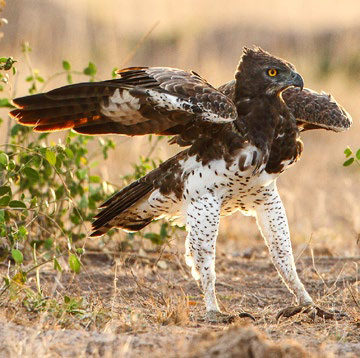
Shimuweni, one of the smaller bushveld camps on our exclusive routes and Mopani, as the name suggests, is situated in the mopane dominated woodland. In general, this area does not hold as great a variety of species as elsewhere in the park but there are some interesting areas and both camps are good locations to break up otherwise long drives between the north of the reserve and camps located further south. The nearby areas of open habitat around Nshawu, for example, give access to some different habitat, which in turn often delivers some interesting birds for the park.
Mopani Camp overlooks the Pioneer Dam, and this water feature often attracts a good variety of waterbirds, including Collared Pratincole, which is a scarce species in Kruger. Recently, the dam has also played host to African Skimmer, a significant record for Kruger and indeed South Africa. The dam also occasionally turns up an interesting duck or two (most duck species are generally scarce in Kruger) or African Sacred Ibis (very uncommon in Kruger). Otherwise, many of the region’s more widespread egrets, herons, storks and waders can be seen at the dam.
The Nshawu area, including the Nshawu Dam, offers some interesting birding, and the area regularly holds Temminck’s Courser, Chestnut-backed Sparrow-Lark, Kittlitz’s Plover, Collared Pratincole, Caspian Plover, and even Rufous-winged Cisticola has been seen here. During times when conditions are wet, species such as Harlequin Quail move into the area; while severe droughts have produced rarities for the park like Grey-backed Sparrow-Lark and Lark-like Bunting.
NIGHT DRIVES
All teams will have the opportunity of doing two night drives. The exact location of your two drives will depend on the final route selected. Success on night drives varies greatly, but the list of possibilities is rather impressive and includes a good number of owls and nightjars, such Spotted and Verreaux’s Eagle-Owls, African Scops Owl, Southern White-faced Owl and Square-tailed, European and Fiery-necked Nightjars and Bronze-winged Courser. On the mammal front: African Civet, both Common and Central African Large-spotted Genets, Side-striped Jackal, the beautiful Serval, Southern Lesser Galago, White-tailed Mongoose, African Savannah Hare, the incomparable Cape Porcupine and Spotted Hyena – besides the Big 5 – are all possible!
THE CHALLENGE COST:
The cost for participating in this fundraising Kruger Birding & Wildlife Challenge is as follows:
COMPETITIVE, SOUTHERN & PHOTO ROUTES:
R23 950 per person sharing * US$1,640
Single Supplement: R5 875 * US$405
NORTHERN NON-COMPETATIVE ROUTES:
R30 950 per person sharing * US$2,140
Single Supplement: R4 475 * US$320
EXCLUSIVE ROUTES:
R32 950 per person sharing * US$2,280
Single Supplement: R6 475 * US$460
This includes:
- All accommodations for 7 nights (accommodations differ depending on route chosen);
- Open air safari vehicles with driver and fuel;
- 2 night drives;
- Dedicated professional bird and wildlife tour leaders;
- First night opening dinner and drinks at Skukuza Safari Lodge;
- Final night presentation, dinner and drinks at Mopani Camp;
- All meals (only if signed up for Exclusive Routes);
- Meals at Makuleke (Northern Non-competitive Route only); and
- Transfers Mopani Camp back to Johannesburg.
The tour fee does not include:
- Visa fees;
- Any flights;
- Transfers to Skukuza Safari Lodge;
- Entry fees (a wild card can be arranged for those that need one);
- All meals except for opening dinner at Skukuza and final night dinner in Mopani; (Comprehensive, Southern & Photo Routes)
- Any drinks except for opening night in Skukuza and final night at Mopani;
- Insurance – cancellation or medical and related expenses;
- Voluntary gratuity for drivers, staff and tour leaders; and
- Telephone calls, laundry, COVID related testing, and other items of a personal nature.
Single Supplement:
Please note that there will be limited single accommodations available at certain camps like Punda Maria and you may have to share even if you have selected to have single accommodation during these nights of the tour. The single supplement cost for this tour will be charged if you wish to have single accommodation. If RBT cannot provide you with a rooming partner for these nights although you choose to share, the single supplement will become applicable. We will make all reasonable efforts to ensure that a rooming partner is found if you do wish to share.
a. Due to constantly fluctuating exchange rates the tour price fixed in (ZAR), and the actual cost in other major currencies such as US$, Euro and GBP will be adjusted according to prevailing exchange rates at the time of final invoicing (usually 4 months before the tour.) The same applies to single supplement rates, which are also quoted in the respective fixed currency.
b. These costs are subject to unforeseen increases in tour related costs and may have to be adjusted as a result.
c. Lastly, we may be forced to change or alter the itinerary and / or the leader at short or no notice due to unforeseen circumstances; please be aware that we will attempt to adhere as close to the original program as possible.
ARRIVAL & DEPARTURE DETAILS:
This tour does not include any airfares. The event begins at Skukuza in Kruger National Park at 3 pm on day 1 and concludes on day 8 with a transfer from Mopani Camp to Johannesburg after breakfast at around 9 a.m. Given the distance between Mopani and Johannesburg and the possibility for road works or other traffic related issues we suggest that departing domestic flights within South Africa should not be booked before 8 pm and departing international flights should not be booked before 9 pm.
The above information in respect of arrivals and departures is a guide only. Precise arrival and departure information will be sent to you in your Tour Confirmation package once the tour has been officially confirmed. If you wish to arrive early and/or depart late and would like assistance in this regard, kindly contact the Rockjumper office.
FLIGHTS:
OR Tambo International Airport, Johannesburg (IATA: JNB) is the main port of entry for international flights into South Africa and is well serviced by all of the world’s major airlines. IMPORTANT: please DO NOT book your international flights until you have consulted the Rockjumper office for confirmation on the status of the tour.
- Tour Information
-
This unique and fun birding and wildlife challenge provides the opportunity to explore the world-famous Kruger National Park in north-eastern South Africa, from its remote north to its vast south. Not only will you get to experience amazing birding and wildlife viewing but you will also be assisting in saving a special bird from imminent extinction. All proceeds raised will go directly to BirdLife South Africa for vital research and conservation work to protect one of Africa’s, and indeed the worlds, most endangered and little-known species – the White-winged Flufftail. Rockjumper Birding Tours has volunteered its resources and expertise to arrange and coordinate this event and will not be benefitting financially.
Kruger National Park is one of Africa’s most famous, oldest, largest and magnificent reserves and will play host to this birding and wildlife challenge during February 2023. In total, a maximum of 19 teams will take part in what will be a light-hearted, exciting competition where teams explore Kruger National Park from top to bottom recording all the species of birds and mammals they encounter over a 7-day period. Each team of up to 9 participants will have its own open safari vehicle, professional safari driver-guide, and experienced volunteer birding leader. Each species of bird and mammal has been allocated points based on the difficulty of locating the species, and the team with the highest score at the end of the 7 days will be crowned the Birding & Wildlife Champions of Kruger. During the challenge, most teams will be exploring the entire length of Kruger – from Berg-en-dal Camp in the south to Punda Maria in the north. There are however a few alternative routes to choose from that are less intense and focus on specific sectors of Kruger (either the south or north). We also have a few exclusive routes that spend time in some of the bush camps, routes that are more centered around photography, and others that take in some of the private concessions in the far north of Kruger, around the Pafuri region. All teams will start in Skukuza with a welcome dinner and end in Mopani for an epic final night of festivities and prize-giving.
The Kruger list stands at over 500 species of birds, and the park is also renowned for its big game and other mammalian fauna (over 150 species recorded to date). This is one of the few places on the planet where iconic African mammals such as Lion, Leopard, Cheetah, African Wild Dog, African Elephant, African Buffalo and White Rhinoceros can still be found in healthy numbers. There is also a huge variety of other mammals including Roan Antelope, Hippopotamus, Black Rhinoceros, African Civet, Honey Badger, Serval and Cape Porcupine.
Bigger than several European countries and US States this vast, pristine park, declared in 1898 by President Kruger of the Transvaal Republic, is home to a variety of different habitat types. These range from acacia-dominated bushveld to gallery forest along the rivers and mopane woodland in the north. Associated with these habitats is an extraordinary volume of birds, and our time in the park is likely to produce a huge variety that could include Arnott’s Chat, Brown-necked and Brown-headed Parrots, Dickinson’s Kestrel, Green-capped Eremomela, Thick-billed Cuckoo, Mosque Swallow, White-breasted Cuckooshrike, Racket-tailed Roller, Bronze-winged Courser, Stierling’s Wren-Warbler, Olive-tree, Icterine and River Warblers, Thrush Nightingale, Retz’s Helmetshrike, African Barred Owlet, Narina Trogon, Black-throated Wattle-eye, Lemon-breasted Canary, Mottled and Bohm’s Spinetails, Senegal and White-crowned Lapwings, Monotonous and Dusky Larks, Bearded Scrub Robin, African Finfoot, Meves’s Starling, Pallid and Montagu’s Harriers, Steppe and Lesser Spotted Eagles, Amur Falcon, Eurasian Hobby, Bushveld Pipit, Coqui Francolin, Harlequin Quail, Corn Crake, Gorgeous Bushshrike, Eastern Nicator, Eurasian Golden Oriole, Yellow-billed Oxpecker and Tropical Boubou. Kruger is also famous for producing national and regional rarities, with species such as Egyptian Vulture, African Skimmer, Orange-winged Pytilia, Northern Wheatear, Southern Hyliota, Broad-tailed Paradise Whydah, Miombo Blue-eared Starling, Madagascan Cuckoo, Basra Reed Warbler, Sooty Falcon and Collared Palm Thrush all being recorded in the past.
THE CHALLENGE ROUTE AT A GLANCE
Below is a selection of the different routes that can be chosen. All teams begin in Skukuza and on the final night, all teams will be based at Mopani for a final night of festivities and prize-giving.
Participants will either meet in Johannesburg at 8am on February 12th or at Skukuza Camp if you prefer. The challenge count will officially kick-off at 3pm on February 12th and will end at 5pm on February 19th. Each team can tally species recorded from the time the camps officially open until they close (sunrise to sunset) and 2 night drives will also be allowed per team (cost included in the challenge fee).
COMPETITIVE
1 Night Skukuza 1 Night Satara 2 Nights Olifants 2 Nights Punda Maria 1 Night Mopani NON-COMPETITIVE – SOUTHERN & PHOTO
1 Night Skukuza 3 Nights Berg-en-dal 2 Nights Olifants 1 Night Mopani NON-COMPETITIVE – NORTHERN
1 Night Skukuza 1 Night Olifants 2 Nights Shingwedzi 2 Nights Makuluke Concession 1 Night Mopani EXCLUSIVE (ROUTE 1)
1 Night Skukuza 2 Nights Biyamiti 2 Nights Tamboti 1 Night Shimuweni 1 Night Mopani EXCLUSIVE (ROUTE 2)
1 Night Skukuza 2 Nights Tamboti 1 Night Shimuweni 2 Nights Sirheni 1 Night Mopani EXCLUSIVE (ROUTE 3)
1 Night Skukuza 2 Nights Talamati 1 Night Shimuweni 2 Nights Sirheni 1 Night Mopani BERG-EN-DAL & BIYAMITI
These are two of Kruger’s southernmost camps and offer up a good variety of habitat to explore. To the east, the Crocodile River and its associated thickets and riverine vegetation can be easily accessed from Byamiti and Berg-en-dal. Byamiti is set out in amongst riverine vegetation and thickets and offers great woodland birding and is well located for Leopard sightings as well. Berg-en-dal meanwhile is surrounded by numerous rocky outcrops, which in turn host a few unique species that can be tricky to locate elsewhere in the park. Both camps also offer access to the hills around Pretoriuskop – another option for additional species that are unlikely to be seen elsewhere.
Berg-en-dal is a large camp and offers up some excellent general bushveld birding while Byamiti is a smaller exclusive busshveld camp. Both offer typical species for the area such as Magpie Shrike, Orange-breasted Bushshrike, Chinspot Batis, Golden-breasted Bunting, Blue Waxbill, Green-winged Pytilia, Yellow-fronted Canary, Black-crowned Tchagra, Black-backed Puffback, Long-billed Crombec, ubiquitous Rattling Cisticola and Southern Black Tit are common and easy to find.
The diminutive Pearl-spotted Owlet – a diurnal owl with a lovely, characteristic call – is also a regular in this area, and wherever present or calling it never fails to attract the attention of numerous birds. At Berg-en-dal there is a small dam, which occasionally produces some interesting species: even White-backed Night Heron and African Finfoot have been recorded before. The thick woodlands surrounding both camps can be some of the best places in the park to search for the uncommon Stierling’s Wren-Warbler; while raptors are also regularly recorded, with Dark Chanting Goshawk often occurring here at higher density than elsewhere in the park. It is also a very good area for Brown Snake, African Hawk-, Wahlberg’s and Martial Eagles; while Gabar Goshawk and Lizard Buzzard are also frequently seen. The riverine zones and thickets associated with the Crocodile River can often be a good place to try for the uncommon African Barred Owlet; while many other common species including Emerald-spotted Wood Dove, Jacobin, Levaillant’s, Klaas’s and Diederik Cuckoos, Burchell’s Coucal, Little Bee-eater, Brown-hooded and Woodland Kingfishers, Red-breasted Swallow, Willow Warbler, Southern Black, Ashy, Spotted and Pale Flycatchers, Black Cuckooshrike, Red-faced Cisticola, Black-headed Oriole, Black-collared Barbet, Red-faced Mousebird and Green Wood Hoopoe can also be found.
Over towards Pretoriuskop, the woodland and habitat change a little and it is well worth spending some time birding this area if time allows. There are two loops, in particular, that take you very close to some rocky outcrops that are good for finding Mocking Cliff Chat, Striped Pipit, Croaking and Lazy Cisticolas, Red-winged Starling, the near-endemic White-throated Robin-Chat, Cinnamon-breasted Bunting and even Gorgeous Bushshrike in the dense thickets that are associated with the outcrops. Pretoriuskop camp is situated in a zone of broad-leaved woodland, which can produce some interesting species such as Green-capped and Yellow-bellied Eremomelas, the tiny Grey Penduline Tit, Bushveld Pipit, Flappet Lark, Groundscraper Thrush, Yellow-throated Petronia, Striped Kingfisher and Yellow-fronted Tinkerbird. The area is also very good for a variety of sunbirds, and common species include White-bellied, Marico and Scarlet-chested; while this is one of the few areas of the park where Amethyst Sunbird can also sometimes be found.
Diederik Cuckoo by Adam Riley Playing cheetah cubs by Glen Valentine SKUKUZA
This camp is one of the most popular in all of Kruger, and is also the largest. The vast camp grounds themselves provide great birding and easy access to excellent riverine thicket and woodland dominated by large Sycamore Figs and Sausage Trees, which is often a magnet for birds. Skukuza is situated on the Sabi River, and there is an excellent network of roads that allow for plenty of quality access to the river and its associated woodland, both east and west of the camp. Much of the surrounding woodland is fairly dense in nature, even away from the river itself.
Skukuza offers excellent chances at finding the majestic Southern Ground Hornbill, which is often seen striding around in small groups, and we will certainly be treated to many encounters with the gaudy Lilac-breasted Roller. Raptors are also numerous in this area, and we will no doubt enjoy sightings of the striking Bateleur, as well as Tawny and Wahlberg’s Eagles, Hooded, White-headed, White-backed and huge Lappet-faced Vultures, and the handsome African Fish Eagle; while other possibilities include Shikra, Lizard Buzzard, Gabar and Dark Chanting Goshawks, the scarce but extremely attractive African Cuckoo-Hawk, Black-chested and Brown Snake Eagles, Lesser Spotted, Steppe, African Crowned and Booted Eagles, African Hawk-Eagle and African Harrier-Hawk.
This area is also famous for regular sightings of the elusive African Wild Dog; while we also stand an excellent chance of finding the endangered White Rhinoceros and, with exceptional luck, its rarer cousin, the Black Rhinoceros. It is also one of the best areas in the park to see the crepuscular Leopard – certainly one of the world’s best-looking cats! In addition, we should encounter Lion, Spotted Hyena, Black-backed Jackal, large herds of African Elephant lounging in the Sabi River, herds of African Buffalo, Waterbuck, the beautiful Bushbuck and pods of Hippopotamus. The persistent troops of playful Chacma Baboons and Vervets will keep us entertained during the heat of the day. The nocturnal Greater Galago is common in the fig trees inside the camp itself.
Southern Ground Hornbill by Adam Riley White Rhinoceros by Markus Lilje Scouring the riverine woodland and thickets along the Sabi River, we hope to encounter White-fronted Bee-eater, Crowned Hornbill, Golden-tailed, Bearded and Cardinal Woodpeckers, Ashy Flycatcher, Grey Tit-Flycatcher, gorgeous White-browed and Red-capped Robin-Chats, Terrestrial Brownbul, Yellow-bellied and Sombre Greenbuls, African, Jameson’s and Red-billed Firefinches, superb Green-winged Pytilia, Bronze Mannikin, Common Waxbill, Pin-tailed Whydah, Red-faced Cisticola and Southern Boubou. The large riparian trees lining the rivers provide perfect nesting sites for weavers, which are extremely well represented in the park and include Southern and Lesser Masked, Village, Spectacled and Thick-billed. Furthermore, we will endeavour to see various species of brightly coloured bee-eaters, kingfishers, rollers and hornbills, along with the occasional Pearl-spotted Owlet. The Sabi River and nearby wetlands also harbour a number of exciting water-associated birds, and we will be on the lookout for the massive Goliath Heron, stately and threatened Saddle-billed Stork as well as the more common Woolly-necked and Yellow-billed Storks, African Spoonbill, Striated Heron, the unique and monotypic Hamerkop, African Black Duck, Wire-tailed and Grey-rumped Swallows, African Pied Wagtail, White-crowed Lapwing, Common Greenshank, Wood Sandpiper, Giant, the delightful Malachite and occasionally Half-collared Kingfishers and, if we are lucky, the rare African Finfoot or unpredictable Greater Painted-snipe.
Time spent birding in Skukuza camp will almost certainly produce African Green Pigeon, with its lovely, mournful, liquid call; while the thickets in camp are excellent for Bearded Scrub-Robin and White-browed and Red-capped Robin-Chats. Other species that are regularly seen in or from the camp include the tiny Little Sparrowhawk, African Goshawk, Water Thick-knee, gaudy Purple-crested Turaco, Trumpeter Hornbill, Black-headed Oriole, the showy African Paradise Flycatcher, Arrow-marked Babbler, Yellow-breasted Apalis, Green-backed Camaroptera, iridescent Collared, Marico, White-bellied and Scarlet-chested Sunbirds and the vocal Black-collared and Crested Barbets.
Noisy flocks of White-crested Helmetshrike are regularly encountered, and we will also be on the lookout for the much rarer Retz’s Helmetshrike, along with its seldom-seen host, the rare and much sought-after Thick-billed Cuckoo. In addition, we will keep a lookout for the amazing selection of migrant cuckoos that visit the park in summer, and these include African, Common, Red-chested, Diederik, Klaas’s, Levaillant’s and Jacobin Cuckoos, as well as the scarce Great Spotted Cuckoo.
Lilac-breasted Roller by Rich Lindie OLIFANTS, TAMBOTI, TALAMATI & SATARA
Secretarybird by Adam Riley This region is often referred to as central Kruger and offers excellent game viewing and birding opportunities. Olifants is a beautiful camp, set on top of a hill with splendid views of the Olifants River below. Being centrally located has numerous benefits, as a wide variety of habitats can be accessed irrespective of the camp you are staying at. These camps are situated on the southern edge of the widely distributed mopane woodland with Satara and Tamboti the furthest south. While mopane as a vegetation type doesn’t hold a wide variety of species, it does have a few specials. From Olifants, there are excellent opportunities to venture south onto the open grassy plains and sparsely vegetated woodlands in the Satara, Talamati and Tamboti areas; while time can also be spent exploring the denser bush country associated with the Olifants River and the mopane woodlands to the north. Further north of Olifants is the Letaba River, which is another area well worth exploring. Letaba has some lovely thickets and tall riverine habitat, including Letaba Camp, which can be especially productive.
African Wild Dog by Adam Riley Olifants camp is an excellent place to see Southern Yellow-billed and Southern Red-billed Hornbills, Bennett’s Woodpecker, African Hoopoe, Grey-headed and Orange-breasted Bushshrikes, Red-headed Weaver, Red-billed Buffalo Weaver, Burchell’s Starling, Mourning Collared Dove and Brown-headed Parrot, amongst many others.
To the south of Olifants, the rich bushveld and grasslands are particularly productive for several special species. These include Kori Bustard – the world’s heaviest flying bird, the magnificent Martial Eagle, Bateleur, Common Ostrich, Marabou Stork and the impressive Secretarybird – a monotypic family and one of the world’s great avian gems. Further specialities that we will search for in the woodland areas include the lovely Orange-breasted and Grey-headed Bushshrikes, African Grey Hornbill, Lesser Grey, Red-backed, Southern White-crowned and Magpie Shrikes, Red-billed Oxpecker riding on the backs of big game, Red-crested Korhaan, Southern Black Tit, noisy Green Wood Hoopoe, Common Scimitarbill, Greater and Lesser Honeyguides, Acacia Pied Barbet, Yellow-fronted Tinkerbird, Sabota Lark, Mosque Swallow, Black Cuckooshrike, Kurrichane and Groundscraper Thrushes, eye-catching White-throated Robin-Chat, melodic White-browed Scrub Robin, Burnt-necked and Yellow-bellied Eremomelas, Black-crowned and Brown-crowned Tchagras, Brubru, dazzling Violet-backed Starling, White-winged Widowbird and Golden-breasted Bunting.
In the expansive grasslands, we will seek out the bold Black-bellied Bustard, Crested and the rare Shelley’s and Coqui Francolins, Swainson’s and Natal Spurfowls, Rufous-naped Lark, Chestnut-backed Sparrow-Lark, European and Purple Rollers, Yellow-throated Longclaw and, with luck, the erratic and nomadic Temminck’s Courser and Crowned and the scarce Senegal Lapwings. This time of the year can also be good for Harlequin Quail and Kurrichane (Small) Buttonquail; while, sometimes, species such as African and Corn Crakes can also be found in the moist grasslands. It is also during mid to late summer when huge flocks of Red-billed Quelea breed in this area. Seeing flocks of these avian locusts filling the sky or descending on a waterhole is an incredible sight, and their eruptions usually also bring about additional interest in the form of Steppe and Lesser Spotted Eagles. It is also during this time of the year when termite alate eruptions take place, sparking the interest of the afore-mentioned raptors, as well as Amur and occasionally Red-footed Falcons, Lesser Kestrel and Eurasian Hobby. Additional summer visitors to these grasslands also include the scarce Pallid and Montagu’s Harriers. In the late afternoon, pairs of boldly-patterned and crepuscular Double-banded Sandgrouse come to the edges of the road to feed, before making their way down to watering holes at dusk to drink.
European Bee-eater by Rich Lindie The sweet grasses in the Satara area are, of course, also excellent for large herds of grazing mammals, such as Common Wildebeest, Plains Zebra and Impala. These huge herds, in turn, support a healthy population of predators, and Satara is particularly well-known for this. In fact, we have an excellent chance of finding Lion, Leopard, Cheetah, Spotted Hyena and the very scarce and highly threatened African Wild Dog in this area. High densities of other game include Southern Giraffe, Greater Kudu, Klipspringer, Bushbuck, Warthog, Chacma Baboon, Vervet and Dwarf and Banded Mongooses, to name just a few.
To the north of Olifants camp are the Letaba River and its associated camp (Letaba), which also offers some excellent birding opportunities. Like many other Kruger camps, it is also situated right on the river, which ensures fabulous access to quality habitat. Letaba camp can be a good place to look for African Barred Owlet, African Scops Owl and Pearl-spotted Owlet; while the river itself is one of the best locations in the park for Grey-rumped Swallow. Other good species include White-crowned Lapwing, Red-capped Robin-Chat and Green-capped Eremomela.
SHINGWEDZI, BATELEUR & SIRHENI
All three camps are in the northern region of Kruger which is justly famous for birding. Shingwedzi camp is fairly large while both Bateleur and Sirheni are smaller bushveld camps that have been included on the exclusive routes. Like many of the camps we stay at during the challenge, Shingwedzi is also situated on a river – the beautiful Shingwedzi, which is often one of the first rivers in the park to stop flowing during drought years. During wet seasons, however, the river can flow strongly and can be quite a site. It also offers good access to excellent riverine woodland and thickets with an extensive road network comprising many loops and a hide (blind) with wonderful views over the river. Mopane dominates the drier areas away from the river to the north and south. North of Shingwedzi towards Sirheni is a river road that follows the Mphongolo River and can offer some good birding opportunities. Further north, towards Babalala, the woodlands give way to more open habitat, with dotted low bushes and grassland, and this area can be extremely productive as well, particularly during the mid to late summer months.
Given time in the area Shingwedzi camp itself is certainly worth exploring, especially during the summer months when migrant warblers are often about, as this is often a good place to look for Thrush Nightingale. The camp has also famously produced Collared Palm Thrush in the past – a mega record for the park and South Africa. Other regular species include Red-headed Weaver, Bennett’s Woodpecker and Mourning Collared Dove.
Red-crested Korhaan by Markus Lilje Dickinson's Kestrel by Adam Riley Near to Shingwedzi is the Kanniedood Dam, which provides further opportunities to boost the waterbird list. As with most Kruger dams, the volume of species is water level dependent; however, Kanniedood can often hold a fair variety of waders, including Marsh Sandpiper and occasionally even White-fronted Plover. To the south of Shingwedzi is some excellent grassland and scattered bush habitat, which is generally very good for species such as Red-crested Korhaan, Black-bellied Bustard, Southern Carmine and European Bee-eaters, Chestnut-backed Sparrow-Lark, Zitting and Desert Cisticolas and even species such as Dusky and Monotonous Larks, when conditions are right.
The area around Sirheni and further north is another fabulous area of open grassland and scattered bush, which again can produce a variety of excellent species. During the summer months, species such as European Roller and Red-backed Shrike are commonly found; while during times of good rainfall, birds that pull in include Harlequin Quail and African and Corn Crakes. Pallid and Montagu’s Harriers, Monotonous and Dusky Larks, Amur and Red-footed Falcons and Lesser Kestrel should all be looked for carefully. Further north towards the junction of the H1-8 and the H13-1, there have even been records of Black Coucal and Rufous-winged Cisticola – both rare birds in Kruger.
PUNDA MARIA & PAFURI AREA (MAKULEKE CONCESSION)
The far northern Punda Maria and Pafuri areas, bordering Zimbabwe and Mozambique, offer up the best birding in all of Kruger, and many species that are typically only found further north are recorded from this section of the park. Punda is situated around a small hill/kopje and even the camp offers up some fabulous birding. The surrounding woodland, which includes the Mahonie Loop, offers up wonderful mixed woodland; while some excellent tall mopane, that holds a variety of specials, can be found between Punda Maria and Klopperfontein and also on the main tar road that leads east along the H13-1 to the junction of the main north-south route from Pafuri to Shingwedzi. The area around Klopperfontein can be extremely productive, as the taller woodlands give way to more open country, with several small wetlands that usually fill up during the rains. One of the major target zones will also be the stunning riverine woodland that flanks the Luvhuvhu River. There is a superb road network in this area, which allows for extensive exploration of this incredible habitat that teams with birds.
The area around the Mahonie Loop and Punda Maria camp offer up a feast of specials in addition to many of Kruger’s more widespread species, and good birds to keep a watch out for include Brown-necked (Grey-headed) Parrot, Eastern Nicator, Narina Trogon, Yellow-bellied Greenbul, Mosque Swallow, Common House Martin, White-breasted Cuckooshrike, Stierling’s Wren-Warbler, Broad-billed Roller, Eurasian Golden Oriole, River Warbler, White Stork, Steppe and Lesser Spotted Eagles, Eurasian Hobby, African Barred Owlet, Yellow-billed Oxpecker, Red-collared Widowbird, Long-tailed Paradise Whydah, Bronze-winged Courser, Double-banded Sandgrouse and Kurrichane (Small) Buttonquail; while numerous rarities have been reported from this loop before, such as Southern Hyliota, African Golden Oriole, Orange-winged Pytilia and Broad-tailed Paradise Whydah. The area also hosts an incredible variety of cuckoos; however, these do become more difficult to find post-breeding once they have stopped calling. Species to look out for include African, Common, Red-chested, Black, Levaillant’s, Jacobin, Great Spotted, Diederik, Klaas’s and Thick-billed.
Temminck's Courser by Markus Lilje White Rhinoceros with older calf by Gareth Robbins To the east of Punda Maria and north towards Klopperfontein is some of the park’s finest mopane woodlands, and it is here where one stands the best chance of finding specials such as Arnott’s Chat and White-breasted Cuckooshrike. Racket-tailed Roller has also been seen here but is rare and seldom-recorded. The area around Klopperfonetin always seems to produce something good, and this is also the best area of the park to look out for Dickinson’s Kestrel; while Senegal Coucal has also been found here recently. The small wetlands occasionally hold Greater Painted-snipe, Lesser Moorhen and Intermediate Egret when conditions are favourable; while Three-banded Plover, Little Grebe, White-faced Whistling and Knob-billed Ducks, Black Crake and African Jacana are usually around.
Further north, the area around Pafuri holds arguably the most exciting birding in all of Kruger. The area can either be visited during a day trip from Punda Maria or else explored extensively while based in the Makuleke Concession or at Baobab Hill. The beautiful Luvhuvhu River holds an exceptional density of birds, and we will be on the lookout for an incredible variety of common and special species. The main bridge crossing over the river is a good place to scan for African Finfoot, which can occasionally be seen here; while Tropical Boubou and Eastern Nicator are regularly seen in the undergrowth. Overhead, there are often swifts and swallows about; and whilst Little Swift is commonly seen, the two special spinetails – Bohm’s and Mottled – the latter is now rather rare these days, should be watched for carefully in this area. Horus Swift is another good bird to keep an eye open for. To the north of the river crossing are some large acacias that often hold Olivetree and Icterine Warblers during the mid to late summer months; while the rare and often overlooked River Warbler has also been seen here. Common Whitethroat and Garden Warbler are two other migratory warblers that are regularly found in the Pafuri area. There have also been records of Basra Reed Warbler from the Luvhuvhu; however, this is a rare vagrant. To the south of the bridge, one gets to an area of palm-dominated savanna, where careful looking and patience could be rewarded with a sighting of the scarce Lemon-breasted Canary, a species that has a definite association and liking for palm groves. This area is also good for a variety of other species, such as Meves’s Starling, Crested Guineafowl and Grey-headed Kingfisher. There is access to roughly 20km of riverine habitat along the Luvhuvhu River, either side of Pafuri Picnic Site, where the birding is simply top-notch. African Openbill, Woolly-necked, Yellow-billed and Saddle-billed Storks, White-crowned Lapwing, African Crowned and Long-crested Eagles, African Cuckoo-Hawk, Little Sparrowhawk, African Goshawk, Tambourine Dove, Purple-crested Turaco, Trumpeter Hornbill, Narina Trogon, African Pygmy Kingfisher, Thick-billed Cuckoo, Scaly-throated Honeyguide, African Dusky and Ashy Flycatchers, Grey Tit-Flycatcher, Green-capped Eremomela, Bearded Scrub Robin, White-browed Robin-Chat, Gorgeous Bushshrike, Black-throated Wattle-eye and Jameson’s, African and Red-billed Firefinches, along with their hosts Purple, Dusky and Village Indigobirds, are all possible. The Luvhuvhu River also supports decent numbers of White-backed Night Heron and Pel’s Fishing Owl, although they are naturally shy and retiring, and can be tricky to locate. Basing yourself at Baobab Hill or Makuleke gives slightly improved chances for some of the really rare species in the far north such as Pel’s Fishing Owl, Three-banded Courser and Racket-tailed Roller.
MOPANI & SHIMUWENI
Martial Eagle by Markus Lilje Shimuweni, one of the smaller bushveld camps on our exclusive routes and Mopani, as the name suggests, is situated in the mopane dominated woodland. In general, this area does not hold as great a variety of species as elsewhere in the park but there are some interesting areas and both camps are good locations to break up otherwise long drives between the north of the reserve and camps located further south. The nearby areas of open habitat around Nshawu, for example, give access to some different habitat, which in turn often delivers some interesting birds for the park.
Mopani Camp overlooks the Pioneer Dam, and this water feature often attracts a good variety of waterbirds, including Collared Pratincole, which is a scarce species in Kruger. Recently, the dam has also played host to African Skimmer, a significant record for Kruger and indeed South Africa. The dam also occasionally turns up an interesting duck or two (most duck species are generally scarce in Kruger) or African Sacred Ibis (very uncommon in Kruger). Otherwise, many of the region’s more widespread egrets, herons, storks and waders can be seen at the dam.
The Nshawu area, including the Nshawu Dam, offers some interesting birding, and the area regularly holds Temminck’s Courser, Chestnut-backed Sparrow-Lark, Kittlitz’s Plover, Collared Pratincole, Caspian Plover, and even Rufous-winged Cisticola has been seen here. During times when conditions are wet, species such as Harlequin Quail move into the area; while severe droughts have produced rarities for the park like Grey-backed Sparrow-Lark and Lark-like Bunting.
NIGHT DRIVES
All teams will have the opportunity of doing two night drives. The exact location of your two drives will depend on the final route selected. Success on night drives varies greatly, but the list of possibilities is rather impressive and includes a good number of owls and nightjars, such Spotted and Verreaux’s Eagle-Owls, African Scops Owl, Southern White-faced Owl and Square-tailed, European and Fiery-necked Nightjars and Bronze-winged Courser. On the mammal front: African Civet, both Common and Central African Large-spotted Genets, Side-striped Jackal, the beautiful Serval, Southern Lesser Galago, White-tailed Mongoose, African Savannah Hare, the incomparable Cape Porcupine and Spotted Hyena – besides the Big 5 – are all possible!
- Booking Form
-
- Financial Arrangements
-
THE CHALLENGE COST:
The cost for participating in this fundraising Kruger Birding & Wildlife Challenge is as follows:
COMPETITIVE, SOUTHERN & PHOTO ROUTES:
R23 950 per person sharing * US$1,640
Single Supplement: R5 875 * US$405
NORTHERN NON-COMPETATIVE ROUTES:
R30 950 per person sharing * US$2,140
Single Supplement: R4 475 * US$320
EXCLUSIVE ROUTES:
R32 950 per person sharing * US$2,280
Single Supplement: R6 475 * US$460
This includes:
- All accommodations for 7 nights (accommodations differ depending on route chosen);
- Open air safari vehicles with driver and fuel;
- 2 night drives;
- Dedicated professional bird and wildlife tour leaders;
- First night opening dinner and drinks at Skukuza Safari Lodge;
- Final night presentation, dinner and drinks at Mopani Camp;
- All meals (only if signed up for Exclusive Routes);
- Meals at Makuleke (Northern Non-competitive Route only); and
- Transfers Mopani Camp back to Johannesburg.
The tour fee does not include:
- Visa fees;
- Any flights;
- Transfers to Skukuza Safari Lodge;
- Entry fees (a wild card can be arranged for those that need one);
- All meals except for opening dinner at Skukuza and final night dinner in Mopani; (Comprehensive, Southern & Photo Routes)
- Any drinks except for opening night in Skukuza and final night at Mopani;
- Insurance – cancellation or medical and related expenses;
- Voluntary gratuity for drivers, staff and tour leaders; and
- Telephone calls, laundry, COVID related testing, and other items of a personal nature.
Single Supplement:
Please note that there will be limited single accommodations available at certain camps like Punda Maria and you may have to share even if you have selected to have single accommodation during these nights of the tour. The single supplement cost for this tour will be charged if you wish to have single accommodation. If RBT cannot provide you with a rooming partner for these nights although you choose to share, the single supplement will become applicable. We will make all reasonable efforts to ensure that a rooming partner is found if you do wish to share.
- Important Notes
-
a. Due to constantly fluctuating exchange rates the tour price fixed in (ZAR), and the actual cost in other major currencies such as US$, Euro and GBP will be adjusted according to prevailing exchange rates at the time of final invoicing (usually 4 months before the tour.) The same applies to single supplement rates, which are also quoted in the respective fixed currency.
b. These costs are subject to unforeseen increases in tour related costs and may have to be adjusted as a result.
c. Lastly, we may be forced to change or alter the itinerary and / or the leader at short or no notice due to unforeseen circumstances; please be aware that we will attempt to adhere as close to the original program as possible.
ARRIVAL & DEPARTURE DETAILS:
This tour does not include any airfares. The event begins at Skukuza in Kruger National Park at 3 pm on day 1 and concludes on day 8 with a transfer from Mopani Camp to Johannesburg after breakfast at around 9 a.m. Given the distance between Mopani and Johannesburg and the possibility for road works or other traffic related issues we suggest that departing domestic flights within South Africa should not be booked before 8 pm and departing international flights should not be booked before 9 pm.
The above information in respect of arrivals and departures is a guide only. Precise arrival and departure information will be sent to you in your Tour Confirmation package once the tour has been officially confirmed. If you wish to arrive early and/or depart late and would like assistance in this regard, kindly contact the Rockjumper office.
FLIGHTS:
OR Tambo International Airport, Johannesburg (IATA: JNB) is the main port of entry for international flights into South Africa and is well serviced by all of the world’s major airlines. IMPORTANT: please DO NOT book your international flights until you have consulted the Rockjumper office for confirmation on the status of the tour.
